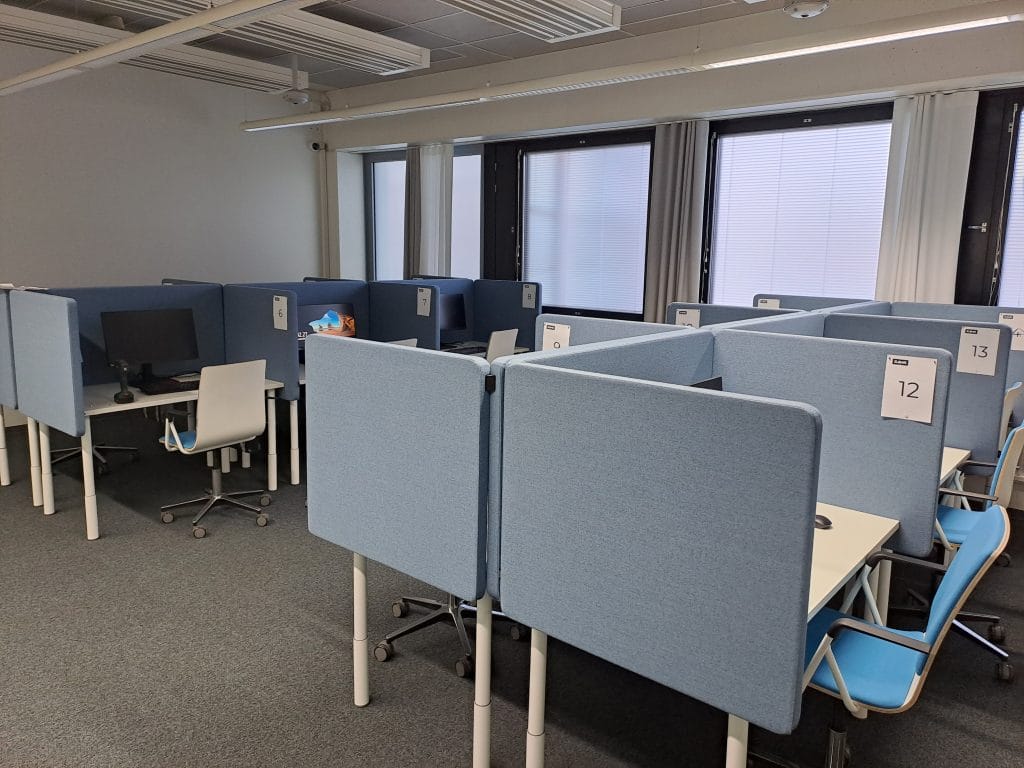
Electronic exams
Xamk Exam
Flexible examinations
All for the future.
What is the Exam?
EXAM is a system that allow students to take an exam or maturity test independently in the Exam room. It is flexible since students are free to choose the time and place of their exam within the framework made available by the teacher and the campus opening hours. Exam room computers can access only to the Exam system and the rooms are equipped with recording video and audio surveillance.
Are you planning to take Exam visit at Xamk? Guides for students of other unversities are availabe on this site below.
Guides for Xamk students and teachers are available in Learn learning environment: Exam guides in Learn.

Exam visit
Exam visit means that you take your own university’s exam in another university’s Exam room. The exam visit is booked in your own university’s EXAM system using your university’s login credentials.
The Exam room has real-time and recording camera surveillance. When you book an exam time at Xamk’s Exam room, you accept the rules and regulations of electronic exams and the surveillance practices. You must follow the rules and regulations of visiting university. In the Exam visit, the recordings of the camera surveillance are handed over to your home university if necessary.
Possible exam times and exceptions can be seen from the booking calendar.
Please read the instructions below. If you have any questions related to the exam visit, please contact your own university’s EXAM support.
Reasonable accommodations for the exam: Students can request reasonable accommodations for the exam from their home university. Arrangements are agreed on a case-by-case basis between the home and host universities.
News
28th October Exam system maintenance break
Exam system will be updated. During the break, Exam is not available. Exam can not be logged in, and used at all.
Taking exams during holiday season
Taking exams in Exam rooms is usually possible during holidays (except on public holidays campus is closed). Note that campus doors are open until 4:15 p.m and make sure to enter the campus before the closing time. At Kotka campus, Satama Areena may be closed. Entering to the campus via eastside of the campus (Kotkamills side).
During festivals the campus is closed (e.g. Kotka Maritime Festival, Kymijoki Beer Festival (Kouvola).
Kotka campus opening hours and leaving the campus
Kotka campus – Satama areena doors are closed after 5p.m. After 5p.m. students must leave the campus from the Kotkamills/salakuljettajantie side.
You can take an exam in Xamk exam visit room if your own institution has enabled the Exam visit service. Before booking an exam, read Xamk’s instructions and rules for electronic exams and make sure that the exam computers have the necessary software for the exam. You book exam through your own university’s Exam system with your university student credentials and password.
The exam room is equipped with recording video and audio surveillance. By registering for the exam, you also give permission for camera surveillance.
- The exam room is equipped with recording video and audio surveillance. When you register for the exam, you also give permission for camera surveillance. In the exam visit, the recordings of the camera surveillance are handed over to your home university if necessary. The Privacy Statement of the Electronic Examination Service in accordance with Section 10 of the Personal Data Act (523/99) and the description of camera surveillance are available on Xamk’s website: Data privacy at Xamk.
- When entering the exam room, please consider other students and avoid strong fragrances.
- Staff may also make random inspections on the premises, so be prepared to prove your identity.
- All personal belongings must be left in the storage lockers near or inside the exam room free of charge. Storage lockers are closed with either a key (Kouvola, Mikkeli, Savonlinna) or with a chip card (Kotka). For storage lockers that are closed with a chip-card, bring your own chip-card, which you can use to lock the door. You can only take your identity/student card and a key to the storage locker with you on the table.
- No food, drink, books, jacket, phone, calculator etc near the exam table.
- Absolute silence must be observed in the exam room! Do not talk to others or blink other people’s machines in the room.
- You must not leave the exam room in the middle of the exam and you must not move away from the machine during the exam.
- Empty storage locker when leaving the exam room.
- No technical support is available during the exam session. If the exam breaks unexpectedly, follow the instructions in the exam room and report your problems to the teacher and Xamk E-kampus support: https://xinfo.xamk.fi or by email xinfo.e-kampus@xamk.fi.
- If you violate the instructions mentioned here, the exam may be rejected.
Exam visit is available on all campuses. No access key is required to enter the campus or the Exam rooms.
The exam rooms are open for exam visit on weekdays (mon-fri). Generally, exams start 15 past every hour (between 8:15 and 16:15). Check more detailed availability from the Exam-system. Reservations can be made maximum 30 days ahead. There are a limited number of machines for exam visits.
- Kotka campus
Exam-room at B4019 (Salakuljettajantie 5). You should enter from the main doors of Satama Areena side (Tornatorintie) and in front of the campus info take the stairs to the 4th floor. Accessible route: The elevator can be found near the campus info after the sports hall on the left. There is only little parking space near the campus, it is recommended to arrive by public transport. Local train stops near the campus.
Special considerations at Kotka: Exam room storage lockers are used with a chip card. Bring your own chip-card with you which you can use to lock the locker door. Leaving the campus after 5pm: Satama areena side is closed, leave from the Kotkamills/salakuljettajantie side: from the exam room take right and stairs down. - Kouvola campus
Exam-room 248A. You should enter through the main entrance (Kuuselankatu, Info) and go straight to the 2nd floor. Cyrillic keyboard available.
See parking info from information below. - Mikkeli campus
Exam-room D206. You should enter through the main doors of the D building (D1/Info) and immediately take the the stairs on the right in the lobby to the 2nd floor. Room D206 is immediately in the lobby on the left. Accessible route: The elevator to the 2nd floor is available through the lobby of the D-building (info). A Cyrillic keyboard is available.
See parking info from information below. - Savonlinna campus
Exam-room SA438. You should enter through the main entrance (door A/Info) and go straight to the 4th floor.
See parking info from information below.
More detailed information on arrival on campuses, student parking and campus map from the link below.
- Access to Exam-system only, other web sources blocked
- Windows -calculator
- Pdf-reader
- Paint (for opening image files)
- Wordpad / Notepad
- Microsoft Office: Word, Excel, Powerpoint (no spelling and grammar checker)
- A few hearing protectors available in the room
- Cyrillic keybords in Kotka, Kouvola and Mikkeli Exam rooms only
- Writing papers, pens and basic calculators for medical exams
- No headsets or drawing tables available.
Login instructions
- If the computer screen is dark or computer is closed, swing the mouse or turn on the computer.
- To log in, select Guest and press Sign in.
- Open Exam/Firefox and select your university from the HAKA organization menu and log in to the exam with your university credentials.
- Wait until your exam opens and proceed to take the exam. When you are finished, close the browser and log out of the computer. You can also shut down the machine.
There is no technical support available during the exam. If a problem occurs, proceed as follows:
- Problems with logging in: make sure you log in with the correct login credentials, in the correct form and with the correct password. Try restarting the computer and logging in again.
- If the exam freezes or stops unexpectedly, try restarting the computer and follow the instructions in the Exam room.
If the problems still persists, problems with exam, please contact your university’s Exam support / examiner. If you have problems with your Xamk exam computer or login, contact to Xamk E-kampus Support: https://xinfo.xamk.fi or by email xinfo.e-kampus@xamk.fi.
South-Eastern Finland University of Applied Sciences EXAM system accessibility statement
This accessibility statement explains how well EXAM system complies with the Act on the Provision of Digital Services, what shortcomings there are in the accessibility of the service and how you can give us feedback on accessibility problems.
South-Eastern Finland University of Applied Sciences is responsible for this system. We want as many users as possible to be able to access our digital services. We take accessibility into account in the development of digital services.
How accessible is the website?
This system partly meets the A and AA level accessibility criteria required by law (WCAG criteria 2.1). The online service has some shortcomings in accessibility, which are described in more detail below.
Did you notice any gaps in accessibility?
We are constantly striving to improve the accessibility of the system. If you observe any issues that are not described on this page, please let us know and we will do our best to fix any shortcomings. We will respond to requests and comments as soon as possible, but no later than within two weeks.
You can contact us by using this online form. (Language options for the online form available: Finnish/English.)
Accessibility monitoring
The Finnish Transport and Communications Agency Traficom monitors the implementation of accessibility requirements. If you are not satisfied with the response you have received or you do not receive a response at all within two weeks, you can give feedback to the Finnish Transport and Communications Agency Traficom. The website of the Finnish Transport and Communications Agency Traficom provides detailed information on how to file a complaint and how the matter will be processed.
Finnish Transport and Communications Agency Traficom
Digital Accessibility Supervision Unit
www.webaccessibility.fi
saavutettavuus@traficom.fi
telephone switchboard 029 534 5000
More detailed information on technical accessibility
The system is not yet fully accessible.
Content or features that are not yet accessible – Student View
Calendar
- Some functionalities of the calendar have inappropriate roles, and some functionalities do not have any role. Screen readers do not read all the content correctly. (WCAG 4.1.2)
- Screen reader users are not notified of all visible changes happening in the calendar. (WCAG 4.1.3)
- Using the calendar with mobile screen reader is very difficult. The screen reader does not always read all the relevant content but reads some irrelevant noise content. In addition, mobile screen reader focus often gets trapped in the calendar. (WCAG 1.3.1)’
Changes of page and other content
- In the search of exams, there is no notification of search results for screen reader users. When changing the subject area of exams, there is no notification of the change of content. (WCAG 4.1.3)
Content or features that are not yet accessible – Tentator and Admin View
General accessibility problems
- The page titles in the service are not unique. (WCAG 2.4.2)
- The parts of the web pages that are in different language do not have correct language attribute. (WCAG
3.1.1 and3.1.2) - Some content does not adapt properly to smaller screens. (WCAG 1.4.10)
- In some cases, the visible keyboard focus indicator does not meet contrast requirements. (WCAG 1.4.11)
- The HTML code of the online service does not fully comply to the specification. (WCAG 4.1.1)
Headings and text content
- In some texts, the screen reader does not interpret line breaks correctly. (WCAG 1.3.1)
Links, buttons and forms
- At some places, the relationships of information are difficult to understand with screen reader. The form fields and their labels are not always programmatically associated. The checkboxes and radio groups of exam questions have not been grouped correctly. In addition, the movement of screen reader focus is not correctly limited in radio groups. This makes it difficult to understand borders of a radio group. (WCAG 1.3.1 and 2.4.3)
- There are extra stops of focus when tabbing through some user interface components. There are also non-informative arrow icons that have not been hidden from screen readers. Sometimes the screen reader reads too much information at one step. Screen reader users receive guidance on how to open a keyboard shortcut guide, but the same information is not given to sighted keyboard-only users who might also benefit from the shortcut instructions. (WCAG 1.3.1)
- Some functionalities do not have an appropriate element or role. At many places, state of functionalities (e.g. whether an accordion is collapsed or expanded, whether a menu item is selected, or if some element is disabled) is not announced to screen reader users. Some functionalities lack an accessible name, or the name is indescriptive or written in English. Actions of these kinds of elements are difficult to understand with screen reader. (WCAG 4.1.2)
- Some functional elements cannot bee accessed at all with keyboard. These functionalities include for example adding an attachment in the exam, the text formatting functions in the text editor, and showing the evaluation of an exam. (WCAG 2.1.1)
Calendar
- Some functionalities of the calendar have inappropriate roles, and some functionalities do not have any role. Screen readers do not read all the content correctly. (WCAG 4.1.2)
- Screen reader users are not notified of all visible changes happening in the calendar. (WCAG 4.1.3)
- Using the calendar with mobile screen reader is very difficult. The screen reader does not always read all the relevant content but reads some irrelevant noise content. In addition, mobile screen reader focus often gets trapped in the calendar. (WCAG 1.3.1)
Non-textual content
- The online service includes icons whose alt text or accessible name is indescriptive and/or in English. Some icons do not have alt text at all. There are also some decorative icons that have not been hidden from screen readers. (WCAG 1.1.1)
Modal dialogs
- The focus is not always directed straight to modals. In some cases, the focus is directed to a position inside a modal that is not logical. When closing a modal, the focus does not always remain in the element from which the modal was opened. (WCAG 2.4.3)
- Some headings in the modals have not been programmatically marked as headings. (WCAG 1.3.1)
Changes of page and other content
- Activating navigation links does not cause ordinary loading of a new page. As a result, a screen reader user does not receive the information that a page has changed. (WCAG 4.1.3)
- In the search of exams, there is no notification of search results for screen reader users. When changing the subject area of exams, there is no notification of the change of content. (WCAG 4.1.3)
- Focus has not been controlled on the website, which results in illogical focus behavior during transitions especially with VoiceOver screen reader. In addition, the tab order of the exam view is inconsistent and differs from the visual reading order. (WCAG 2.4.3)
An effort will be made to correct the shortcomings listed in this statement by 31 December 2026.
How have we tested accessibility?
The observations in this accessibility statement are based on a third-party assessment of whether the online service meets legal requirements.
The online service was published on 1 September 2017 and updated on 16 January 2025.
This statement was prepared on 19 May 2023.
The statement was last updated on 25 October 2024.
Act on the Provision of Digital Services (306/2019) (in Finnish and Swedish)
Accessibility Requirements website (in Finnish and Swedish)




